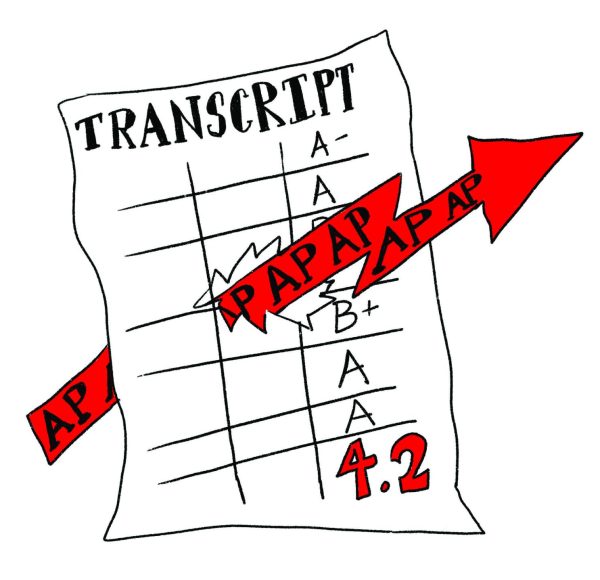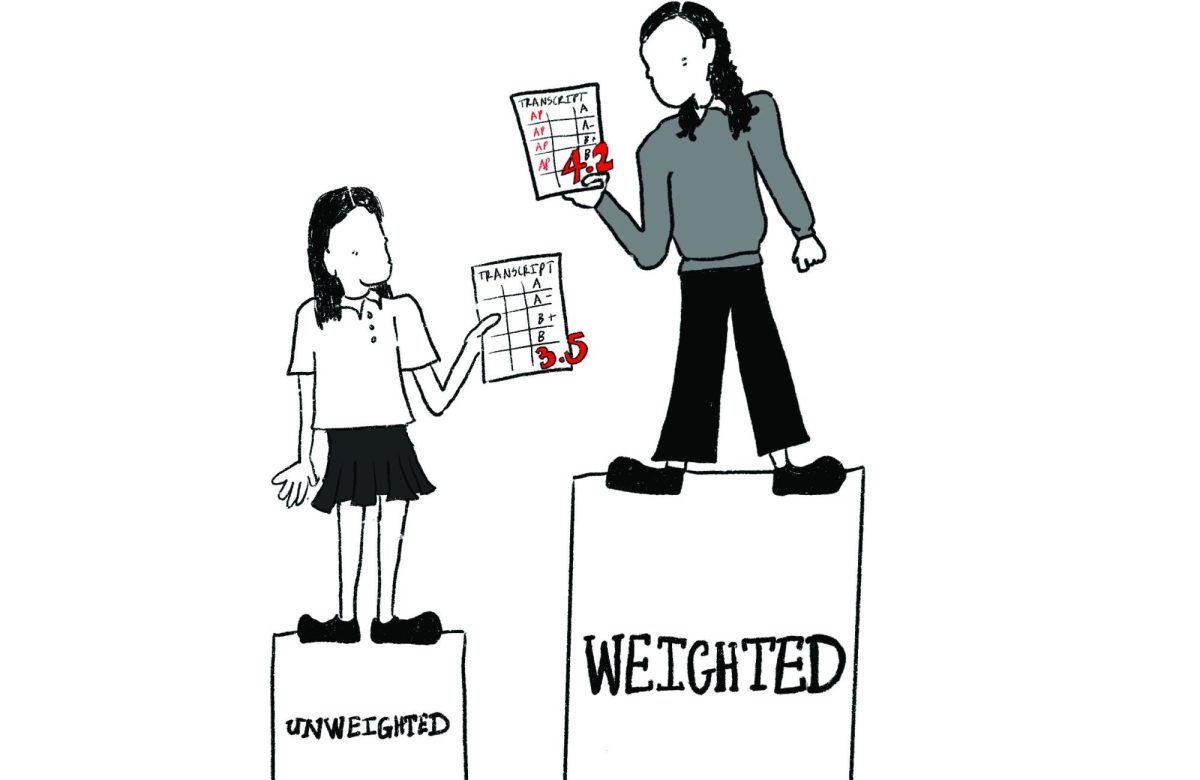Background
The term “grade inflation” refers to the phenomenon through which average grades awarded to students increase over time without corresponding higher academic achievement. When grades are inflated, students receive higher grades but are not necessarily doing better work.
While students may view grade inflation as a recent phenomenon — a byproduct of post-pandemic grading policies — the term was coined by Harvard sociologist David Riesman in the 1970s when the pattern of grade inflation first began in colleges.
Duke researcher Stuart Rojstaczer cites the 1960s and 1970s, the Vietnam Era, as the starting point for when colleges began to inflate their students’ grades. During the Vietnam War, lower GPAs could put male students at risk for being drafted, as military exemptions were given to college students with higher grades. Therefore, in order to prevent young men from being drafted, college professors inflated their student’s grades. According to Rojstaczer, A’s made up 15% of grades given in college classes in the early 1960s before the Vietnam War influenced grading standards. By the 1980s, that number had doubled and A’s constituted 30% of grades awarded to college students.
While the Vietnam War era was the beginning of grade inflation, the trend has rapidly increased in both high schools and colleges over the last few decades. A paper by the College Board in 2016 found that between 1998 and 2016, national high school GPA averages rose by .11 of a GPA point, while SAT scores declined slightly at the same time.
Rojstaczer believes that one of the causes of grade inflation is the rise of a “consumer culture” in education, in which students and parents, who are paying for their child’s education, feel entitled to receive desirable grades and use their financial influence to exert power over teachers. It has become increasingly common for students and parents to ask their teachers for better grades than they have earned.
A 2023 poll conducted by Intelligent.com found that out of 288 high school teachers and college professors, 44% say that students often ask for better grades than they have earned, and 82% have given higher grades due to fear of retaliation or harassment. Furthermore, 45% of those surveyed believed that Gen Z students ask for better grades more frequently than previous generations.
Despite the acknowledgement that grade inflation is an ongoing issue, the culture of inflation is contagious. If one institution attempts to curb grade inflation by reducing the number of A’s given to students, it may put their students at a disadvantage in the marketplace when they are applying to college or jobs. In 2005, Princeton University capped its rate of A’s at 35%. However, when other institutions did not do the same, Princeton grads were outcompeted in the marketplace, leading the university to reverse its policy in 2014.
Although grade inflation is certainly not a new phenomenon, it has ramped up since the COVID-19 pandemic when many educators revised their grading policies to help students during remote learning. In the Los Angeles Unified School District (LAUSD) and other California districts, many teachers adopted “compassionate grading” policies in response to the disruption caused by the pandemic. Teachers gave students additional time to make up work, more opportunities to retake tests and extra chances to turn in assignments.
A 2022 Los Angeles Times analysis of several California school districts found that middle and high school math and English grades not only rebounded from but exceeded pre-pandemic grades. At the same time, math and English proficiency rates on California standardized tests declined to their lowest levels in five years.
In spring 2019, around 69% of 8th graders earned A’s, B’s and C’s, compared to 79% earning these grades in spring 2022. However, in spring 2022, around 72% of students across all tested LAUSD grade levels did not meet state standards in math and around 58% did not meet state standards in English.
Grade inflation can be particularly prevalent in affluent schools, whose reputation among prospective parents largely depends on the percentage of students they send to selective colleges. Richard Weissbourd, director of the human development and psychology program at Harvard’s Graduate School of Education, explains this trend.
“[Private schools] need to be able to tout how many of their students went to selective colleges [in order to be] attractive to parents,” Weissbourd toldthe Hechinger Report. “So they’re incentivized to give good grades.”
 A’s at Marlborough
A’s at Marlborough
Since its founding, Marlborough has always cultivated and valued academic excellence, but grade inflation, defined as a rise in the average grade assigned to students, affects Marlborough through the way students discuss grades. When grades are inflated, many students at Marlborough and beyond view any grade below an A- as “bad.” An anonymous poll sent to Marlborough students found that 45% of 62 students agree that anything below an A- (89.5-92.49%) is considered a bad grade based on schoolwide standards. When asked about what constituted an individual “bad grade,” however, the results were less extreme, with 27% students saying a grade lower than A- was unacceptable, followed closely by 24% of students who believe anything less than a B+ (86.5-89.49%) is below par. 61% of students believed that an A- was an average grade at Marlborough and 26% assumed an average grade was an A.
Although marginal differences between the schoolwide and personal beliefs of what makes a bad grade are present in the data, the grades deemed poor are not inherently “bad” from a nationwide perspective (the average GPA in the United States is 3.0, which is straight B’s). All the grades mentioned above significantly exceed the passing grade for Marlborough, which is a D+ for grades 9-12 and a C for grades 7-8.
“It’s a social norm that we uphold every day by our reactions towards the grades we receive,” an anonymous Marlborough student said. “At Marlborough, there’s a clear disappointment when essentially anything below an A is received … the act of expressing [disappointment] in front of others who could have gotten that grade or lower creates a toxic atmosphere where learning becomes solely an academic competition.”
Some students believe that the social norms mentioned by this student are prominent in nearly every class post-assessment, including the prevalent desire to gauge how well one did in comparison to classmates.
Other students brought up the impacts of A- grades being negatively portrayed, highlighting a tendency to lie about grades due to shame, embarrassment or a desire to be viewed by peers as having a good academic standing.
“I think sometimes Marlborough students falsely represent their grades to others (ex. only talking about A’s that they have and never mentioning the B’s or C’s), which can make other students think that everyone around them has straight A’s,” an anonymous student said.
“Therefore, getting a B makes you feel like you’re doing worse than everyone else, even if that is not the case.”
Students and teachers alike are certainly aware of grade inflation, but many teachers do not think it is inherently negative. Eric Reinholtz, Dean of External Student Programs and former Dean of Studies, believes that although Marlborough has been seeing a rise in GPAs in the past two decades, it is not indicative of a lack of rigor.
“We are enrolling academically stronger students; those students may be working harder,” Reinholtz said. “The overall quality of teaching at Marlborough is, in my opinion, the best it has been in 20 years.”
Another factor Reinholtz mentioned relating to inflated grades at Marlborough is pressure on teachers to be overly-generous while grading because of “grade-grubbing,” which is when a student asks an instructor to raise their grade for no substantial reason.
In terms of individual classes, Reinholtz credits the implementation of detailed rubrics for the creation of more clearly defined, standardized grading systems. The increased use of rubrics across courses of all levels at Marlborough represents a move toward equitable grading by evaluating every student using the exact same criteria. The rubric system seeks not to focus on the amount of A’s being produced by any given class, but rather analyzes the level of understanding demonstrated on each assessment.
Reinholtz said that if there is a larger grade-inflation trend across America, Marlborough’s high grades are not reflective of it.
“If the implication is that higher grades mean a decline in rigor or excellence, then Marlborough is in the same boat as the Ivy League,” Reinholtz said.
An inflated future
Although the prevalence of grade inflation varies from school to school, there has been an overall rising trend at colleges in the United States. As Marlborough’s GPAs increased in recent decades, Harvard simultaneously saw an increase, with 80% of all grades now being A’s, according to an article published in the Harvard Crimson.
The Los Angeles Times attributed the continuation of grade inflation in postsecondary education to, in part, a push by the U.S. Department of Education to produce more college graduates. Additionally, many college professors, most of whom have very few job protections, fear negative evaluations by students which can jeopardize their careers, thus grading their pupils more easily.
The nationwide epidemic of giving out A’s too easily in high school subsequently has students facing repercussions later in their academic careers, or more likely, finishing college having maintained the same inflated grades. However, some recent Marlborough graduates do not feel as though grade inflation has had an effect on their college experience. One Marlborough graduate remarked about how the transition from high school to college was seamless. She felt like beginning college was not such a large academic jump from Marlborough that she couldn’t keep up.
“I didn’t feel as though Marlborough gave out A’s too easily in any way that affected my college experience,” the graduate said. “I felt well-prepared for college by the time I graduated from Marlborough.”
As the title of a recent Forbes article states, grade inflation is not a victimless crime. The epidemic impacts students, parents, teachers and educational institutions alike.
Grade inflation in high school gives students a false sense of academic achievement, according to the Forbes article. Thus, when these students graduate high school, they lack the fundamentals that are necessary to prepare them for college. Brown University researchers found that “easy A’s” undermine learning, as students learn less from teachers who are easier graders because they don’t feel the need to study as much when it is less challenging to get a good grade.
Additionally, because grade inflation acts as a false indicator of academic success, parents are less likely to give their children academic support when it is needed. Morgan Polikoff, an associate professor of Education at the University of Southern California, believes that grade inflation makes parents less worried about their child’s performance even when it may be declining.
“Schools are sending the signal via grades that kids are doing well again,” Polikoff said. “That’s one of the reasons we see parents are so unconcerned about student performance at the same time that student performance is declining on these objective measures.”
Furthermore, when grades are concentrated in the “A” range as a result of grade inflation, college admissions officers lose valuable information that they would previously have used to assess a student’s strengths and weaknesses. According to expert educational psychologist Jed Applerouth, a high GPA is no longer enough to determine whether or not an applicant is qualified to be admitted to a university. This leaves many educational institutions grappling with how to respond to grade inflation.
In terms of the college admissions process, grade inflation post-pandemic is one of the reasons why more colleges are reinstating standardized test requirements, such as the SAT or ACT, in order to validate applicants’ grades and evaluate their academic performance on a more objective basis. Christina Paxson, president of Brown University, confirmed this sentiment in a statement written about Brown’s standardized testing policies.
“Standardized test scores are a much better predictor of academic success than high school grades,” Paxson wrote.
In order to combat grade inflation, some institutions, like Marlborough, have started to implement mastery- or proficiency-based grading, by which students work to meet objective content and skills-based standards and are assessed on the level of proficiency they reach. This system may do a better job of accurately representing student progress than grade-based learning does, according to educator Seth Czarnecki. However, despite attempts to curb grade inflation, a GPA-centered academic culture is still prevalent at Marlborough and beyond.
“[B’s and A’s] aren’t inherently bad,” an anonymous student said. “It’s just the Marlborough culture to keep on pushing and trying to overachieve.”








